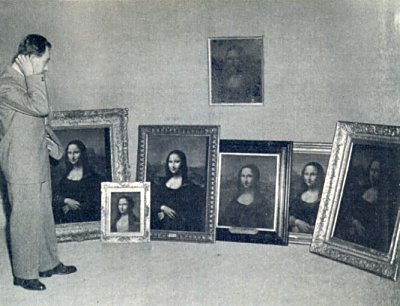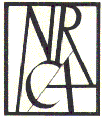| HOSTED BY |
A History of Art Forgery
 |
Genuine of forgery? Eight versions of the Mona Lisa make a puzzle for the art lover. This famous painting has constantly figured in questions of forgery, but it is only the tip of a gigantic iceburg. |
INTRODUCTION
Artists have been copying the images and the styles of other artists for thousands of years. Up until around the 16th Century this was a common practice, used to pass down historical, religious and artistic tradition for future generations. Copying the work of others, and particularly the Masters, was a normal part of any artist's academic training. It still is, in major art schools, a normal and required part of an art student's cirriculum. The purpose of art in those days was for historical reference, religious inspiration, or simply aesthetic enjoyment; and the identity of the artist was of little importance. Accomplished artists were respected and rewarded handsomely; but few knew or cared who they were except perhaps for their patrons, who were usually the Church or the State. Redistribution of the world’s wealth after the Renaissance created an explosive demand for art by a newly educated and prosperous mercantile middle class. Guilds of Master artists and students became virtual factories for art that was produced to fill this demand. The sale of State and Ecclesiastical art collections created new secondary markets in the form of dealers, galleries and auction houses. For the first time in history, art became a commercial commodity. Some criterion for judging the monetary value for all this art was needed, and the most readily available one was the identity of the artist. First, this took the form of mark on the work, and later a signature. As the demand for fine art far exceeded the supply, misuse of these marks and signatures became rampant. Controlling legislation was enacted as it always is whenever commerce enters the picture, and the formerly respected tradition of copying art became art forgery. The laws of supply and demand dictate that there will be no end to the growing commercial value for a limited number of great works of art; and as long as those who deal in the commercial aspects of art — galleries, art dealers, auction houses and the media — are involved as the arbiters of criteria in judging art, market prices will continue to rise and art forgery will proliferate.
|
| Joe. L. Dolice, NRCA |
| History of Art Forgery |
| Special thanks to people without whom this exhibition would not have been possible: Thea Eichler, NRCA; Billie Tucker, New Rochelle Library; Ivar Hyden, Backstreet Gallery and all the contributing artists. |
| Additional information about the availability of Fabulous Fakes, the History of Art Forgery or any of the works in the exhibition may be obtained by contacting The New Rochelle Council on The Arts by email or by calling 212-529-2025. More information on the NRCA can be found by connecting to the internet and clicking here. |
 Fabulous Fakes and A History of Art Forgery © J. L. Dolice, 2001, 2003.
|
| All images in this presentation may not be copied, stored in any electronic retrieval device or used in any way without permission in writing. ISBN 0-935901-51-5. |
| Art Forgery | Art Haus |